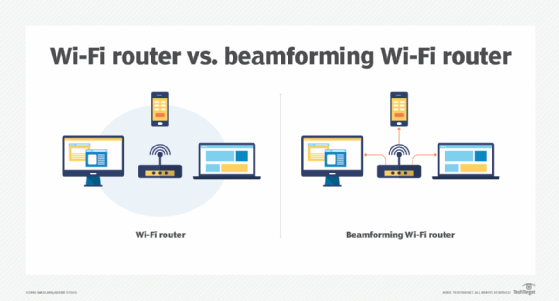beamforming
What is beamforming?
Beamforming is a type of radio frequency (RF) management in which a wireless signal is directed toward a specific receiving device. Beamforming is applied to numerous technologies, including wireless communications, acoustics, radar and sonar. The RF management technique directs radio and sound waves for signal transmission or reception.
Rather than sending a signal from a broadcast antenna to be spread in all directions -- how a signal would traditionally be sent -- beamforming uses multiple antennas to send out and direct the same signal toward a single receiving device, such as a laptop, smartphone or tablet. The connection results in a faster, more reliable wireless data transfer.
The concept originates from 1905, but more recently, the technology has been applied to Wi-Fi and fifth-generation (5G) networks. As an example, the 802.11 standard gives a specification for routers to implement Wi-Fi beamforming.
How does beamforming work?
Beamforming works differently, depending on its type or implementation. However, by having multiple antennas in close proximity send out multiple signals at different times, a beamforming tower or router can adjust the signals it sends. This adjustment determines the best path for the signal to take to reach the client device. In a sense, beamforming shapes the RF beam as it traverses a physical space.
The radiating elements -- or parts of the antenna designed to support RF currents -- in multiple antennas need to transmit a signal at identical wavelengths and phases.
Other beamforming techniques include the following:
- Analog beamforming uses phase-shifters to send the same signal from multiple antennas. The signal is set to different phases, which creates an antenna pattern that points a specific direction. The signal phases of antenna signals are adjusted in an RF domain, which improves coverage.
- Digital beamforming has different signals for each antenna in a digital baseband. Digital receivers are placed at the radiating elements of each antenna. Different phases are applied to different frequency bands, enabling digital beamforming to be more flexible. A digital beamforming processor can then steer numerous independent beams in any direction. This method is useful for spatial multiplexing.
- Hybrid beamforming is a combination of analog and digital beamforming. The hybrid approach uses analog beamforming along with digital precoding, which is used to support multistream transmission, to form the patterns transmitted from an antenna array. The process defines the number of analog beams while allowing for some frequency variations. 5G base stations can use hybrid beamforming.
- Massive MIMO, or multiple input and multiple output, is an antenna technology for wireless networks where multiple antennas are used at both the transmitter and the receiver ends. Massive MIMO uses a common frequency that is then steered in multiple directions. It requires digital signal processors and an area with a lot of signal interference. The different signal arrival times form multiple time-division duplexing channels, providing path redundancy. Massive MIMO is used in wireless, Wi-Fi and 5G technology.
- Beam steering changes the phase of input signals on each radiating antenna element. This method essentially tracks the receiving device, steering a signal to it. A common frequency is steered with a signal beam in the correct direction. Meanwhile, different signals can be sent to other devices.
5G beamforming
Beamforming can be used with 5G signals to overcome the obstacles 5G typically faces, including interference and range limitations. 5G beamforming enables more focused signals to be sent to a receiving device like a smartphone or laptop. The process minimizes interference between individual beams.
Hybrid beamforming and massive MIMO are common candidates for 5G. Massive MIMO, for example, may use multi-antenna arrays and spatial multiplexing to transmit multiple independent signals.

Benefits of beamforming
Advantages of beamforming include the following:
- More power is directed in the beam's specified direction.
- Higher signal quality reaches the receiving device, which increases the coverage capacity of the cell tower or base station.
- There are faster information transfers and fewer errors.
- Signal interference between devices is avoided since signals are only broadcast where needed.
- Analog beamforming is relatively simple to implement and has lower power requirements.
Current limitations of beamforming
Beamforming does have limitations, however:
- It sometimes requires more computing resources and power for beamforming calculations.
- Digital and massive MIMO beamforming systems may be more complex, especially considering more antennas and other hardware used.
- Its cost tends to be higher than traditional systems.
Beamforming costs and considerations
There are several factors to consider when implementing beamforming:
- The high frequencies and a large number of antenna elements can be costly.
- Digital beamforming requires transceivers for each antenna, adding to the cost with increased power consumption.
- MIMO systems and beamforming algorithms can be complex.
- Antenna performance, beam characteristics and beam management algorithms should be carefully considered and chosen, as they will affect performance.
- Consumer-facing products, such as routers, can be expensive -- with some routers ranging from around $90 to $350.
Future of beamforming technology
Beamforming has the potential to become more common in Wi-Fi and 5G networks, and it may become a necessary technology to help communication networks meet future data rates and network capacities. In addition, as beamforming algorithms improve, beamforming will be able to select the best data paths.
Learn more about the top 5G challenges for businesses and how beamforming can help mitigate them.







